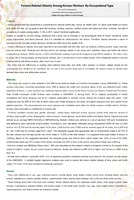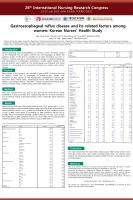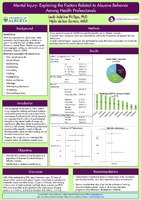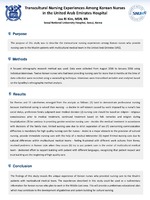| dc.description.abstract | <p>Session presented on Saturday, July 26, 2014:</p>
<p><strong>Purpose:</strong> Korean government has established a comprehensive national health plan, known as Health 2020, for nation-wide health promotion and, under the plan, set up goals to deal with smoking, drinking, exercise, nutrition issues and acted upon them. However, the rate of prevalence of obesity among adults, 31.9% in 2011, haven't declined significantly. Obesity is caused by chronic energy imbalance and it gives rise to changes in the physiological level of insulin resistance, blood sugar, triglycerides, and blood pressure. And it is classified as cardiovascular risk factors. Therefore, obesity becomes a cause of premature death and also various diseases not fatal but affecting on the quality of life. Factors affecting on obesity have been reported to be associated with life style, such as smoking, drinking alcohol, sleep, exercise, physical activity level. Smoking and drinking alcohol are strongly related to job stress and, therefore, these are health risk factors among Korean workers. OECD reports, in 2013, that Koreans' working hours are the longest among OECD countries. Therefore, there is a high risk of having obesity, among Korean workers, due to excess level of work related stress, which frequently results in workers drinking heavily with fellow workers, after long-hours of work. But, there may be differences in working style between blue-collar and white collar workers, so factors related obesity by the occupational type needed to be examined. So, the aim of the present study was to investigate the factors related to obesity risks between blue collar and white collar workers.</p>
<p><strong>Methods:</strong> This study was based on data obtained in the Fifth Korea National Health and Nutrition Examination survey (KNHANES V). These surveys have been conducted periodically since 1998 to assess the health and nutritional status of the non-institutionalized civilian population of Korea, a cross-sectional and nationally representative survey by the Korea Centers for Disease Control and Prevention. Total 10,589 individuals (3,289 families) were included in KNHANES V; among them, 76.1% subjects participated in health surveillance and blood sampling and 82.4% subjects participated in nutrition survey. Among the subjects aged ?20 years, 1,292 employees over the BMI of 18.5 blue or white collars were finally included in this study. All subject measurements were performed by trained examiners. The blood pressure and serum glucose and cholesterol were taken by skilled nurses in mobile vehicle. Nutrition surveys were conducted by nutritionists in a home visit. Predictor variables: Predictor variables included age, gender, education, marital status, individual income, physical activity level, exercise, amount of drinking, body weight control, sleeping time, BP, serum glucose, serum cholesterol and dietary factors. Hypertension was defined as an average SBP?140mmHg or DBP?90mmHg (The Korean Society of Hypertension, 2007). According to such standards, estimated energy requirement (EER) for man is 2,600 kcal for man (2,100 kcal for woman) aged 19-29 years, 2,400 kcal for man (1,900 kcal for woman) aged 30-49 years, and 2,200 kcal for man (1,800 kcal for woman) aged 50-64 years. The standards suggest that appropriate ratio of carbohydrate intake is 55-70% of the total calories and that appropriate ratio of fat intake is 15-25% of the total calories. It is suggested that target intake of sodium is 2,000mg. Based on the suggested standards, the adequate group was defined when calorie intake was 100% or less of the EER, carbohydrate intake was 70% or less of the calorie, fat intake was 25% or less of the calorie, and sodium intake was 2,000 mg. Outcome variables BMI was calculated as the subject's weight in kilograms divided by the square of the subject's height in meters. As per current recommendations, obesity was defined as BMI 25.0 or higher and normal as a BMI of less than 18.5 All data were analyzed, using IBM SPSS 19.0, to generate population weighted estimate accounting for the complex sample design of the KNHANES. A multiple logistic regression analysis was used to assess the factors related to obesity among blue collars and white collars. A P-value <0.05 was considered statistically significant.</p>
<p><strong>Results:</strong> There were differences in sex, age, individual income, marital status, body weight control, stress level. smoking status, physical activity, hypertension, obesity, diabetic mellitus, carbohydrate, and fat intake between blue collar and white collar workers. Blue collar workers, subjective health status, body weight control, sleep duration, hypertension, diabetic mellitus, and sodium intake. White collar workers, sex, age, body weight control, hypertension, hypertriglycemia, and sodium intake (Table 2).</p>
<p><strong>Conclusion:</strong> Depending on the occupational type, there were differences in the factors related to obesity.</p> | en |





